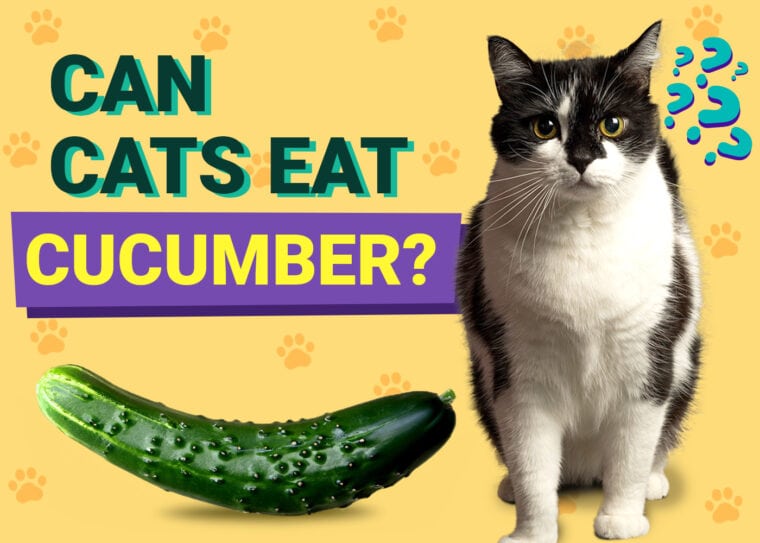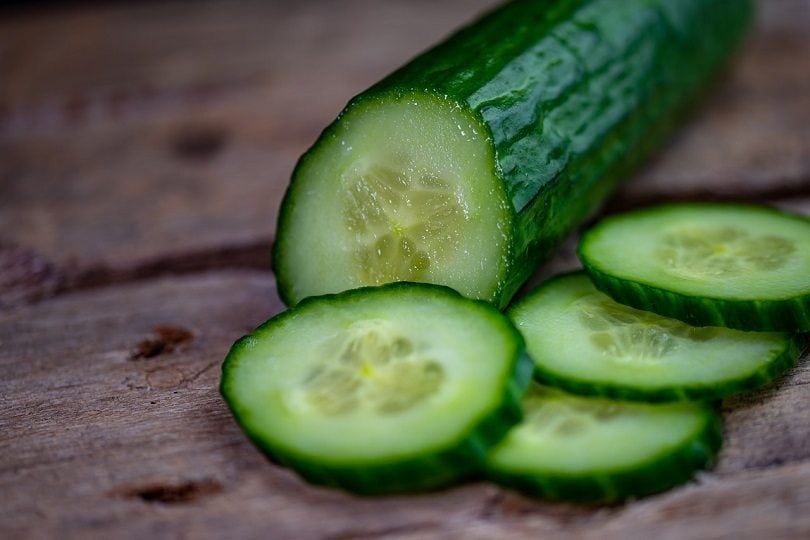
Click to Skip Ahead
When you think of cats and cucumbers, you might think of the viral video trend of kitties being scared by the vegetables. But if your cat would rather eat a cucumber than run away from it, is it okay to let them? Yes, cats can eat cucumber, which may even provide some health benefits.
Keep reading to discover why cucumbers are a healthy snack for your cat and how to feed them as part of a balanced diet. We’ll also suggest other safe human foods your cat may enjoy if cucumbers aren’t quite their taste.
Why Cucumbers Are a Healthy Snack for Cats
Cucumbers are low in calories and contain no fat. One medium cucumber contains approximately 3 grams of protein and other essential nutrients like Vitamin K, potassium, and fiber. In addition, they are almost 95% water.
Many cats struggle to drink enough water, and eating food with increased moisture, such as cucumbers, can help them stay hydrated. Cats on a strict diet can enjoy cucumbers knowing they contain no fat and minimal calories.

But Wait, Aren’t Cats Carnivores?
As you might be aware, cats are considered obligate or true carnivores. This means their bodies are adapted to process and use nutrients primarily from animal protein. Knowing this, you might wonder whether cats benefit from the nutrition found in cucumbers.
Interestingly, research suggests that not only can cats digest protein from plant sources, but they may also digest it better than animal protein in some cases1. However, cats do use some vitamins from animal sources better, such as Vitamin D. With this scientific support, you can feel good about feeding your cat cucumbers, knowing the nutrition won’t be wasted.
How to Feed Your Cat Cucumbers
Despite the nutritional benefits of cucumbers, they certainly don’t contain all the nutrients your cat needs for a balanced diet. Therefore, cucumbers should be fed as treats rather than as a meal. Most of your pet’s daily calories should come from a nutritionally balanced food formulated for cats.
Treats of any kind, including cucumbers, should make up only 10%–15% of daily calories. Again, cucumbers are a low-calorie food, so eating them won’t take up too much of your kitty’s daily allowance. Ask your vet to help you calculate how many calories your cat needs per day based on their age, size, and activity level.
Since the seeds and peel are harder for felines to digest, it’s best to peel and deseed the cucumbers before offering them to your cat. They can be fed raw, or you could try steaming them for a minute to make them softer. However, raw vegetables are the most nutritious.
Knowing exactly what your feline companion can and cannot eat will help you become the best pet parent. Recognizing that not all cat bowls are equal is also key! The Hepper NomNom Cat Bowl sets itself apart from traditional options by catering to the specific needs of cats. The innovative design offers whisker relief via shallow dishes and promotes digestion with a slight bowl elevation. Find out if the Hepper NomNom is right for your cat by clicking here.
At Pet Keen, we’ve admired Hepper for many years and decided to take a controlling ownership interest so that we could benefit from the outstanding designs of this cool cat company!

Other Safe Human Foods to Feed Your Cat
If your cat doesn’t seem to enjoy the slightly bitter taste of cucumbers, here are some other safe human foods they may prefer to try:
Cats are also lactose intolerant and may not be able to digest dairy products like cheese, but they are technically safe to feed your cat in moderation.
Conclusion
Cucumbers are an excellent choice if you’re looking for a healthy, safe snack both you and your cat can enjoy. Remember to check with your veterinarian before offering any new food to your cat. In addition, keep in mind that even safe foods could upset your cat’s stomach as they get used to eating them. Introduce cucumbers slowly and monitor your feline friend for any concerning signs, such as vomiting or diarrhea.
Related Reads:
Featured Image Credit: Monika Stawowy, Pixabay









